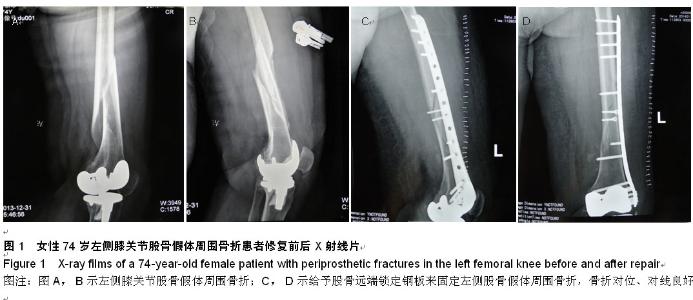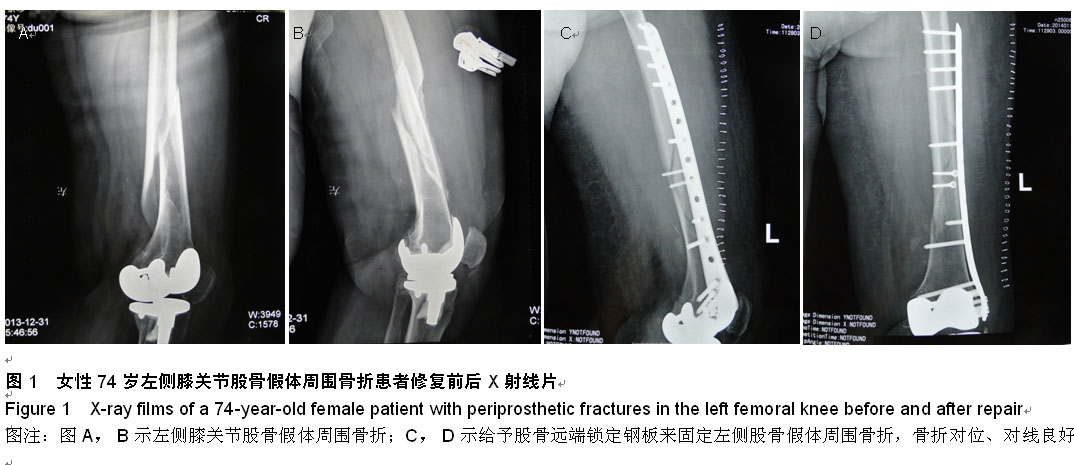| [1] Kim KL, Egol KA, Hozaek WJ, et al. Periprosthetie fractures after total knee arthroplasties. Clin Orthop Relat Res. 2006; 28(16):167-175.
[2] Felix NA, Stuart MJ, Hanssen AD. Periprosthetie fracture of tibia associated with total knee arthroplasty. Clin Orthop Relat Res. 1997;(345):113-124.
[3] 李晓淼,王伟力.全膝关节置换后假体周围骨折的治疗进展[J].中国组织工程研究与临床康复,2009,13(13): 2527-2530.
[4] Erhardt JB, Grob K, Roderer G, et al. Treatment of periprosthetic femur fractures with the non-contact bridging plate: a new angular stable implant. Arch Orthop Trauma Surg. 2008;128(4):409-416.
[5] Iorio R, Robb WJ, Healy WL, et al.Orthopaedic surgeon work force and volume assessment for total hip and knee replacement for total hip and knee replacement in the United States:preparing for an epidemic.J Bone Joint Surg Am. 2008; 90(7):598-1605.
[6] Talbot M, Zdero R, Schemitsch EH, et al.Cyclic loading of periprosthetic fracture fixation constructs.J Trauma. 2008; 64(5):1318-1312.
[7] Sun QL,Fu Y,Sun AP, et al. Correlation of E-selectin genepolymorphisms with risk of ischemic stroke: a meta- analysis. Neural Regen Res.2011;6(22):1731-1735.
[8] Kumari L,Li W,Huang JY,et al.Solvothermal Synthesis, Structure and Optical Property of Nanosized CoSb(3) kutterudite. Nanoscale Res Lett.2010;5(10):1698-1705.
[9] Nabil AE, Liu JY, Sohaib ZH, et al. High Complication Rate in Locking Plate Fixation of Lower Periprosthetic Distal Femur Fractures in Patients With Total Knee Arthroplasties. Arthroplasty.2012;5(27): 809–813.
[10] Hou Z, Bowen TR, Irgit K, et al. Locked Plating of Periprosthetic Femur Fractures Above Total Knee Arthroplasty. J Orthop Trauma. 2012;7(26):427-432.
[11] 赵加林.记忆合金环抱器治疗股骨假体周围骨折1例报告[J]. 安徽医学,2012,32(5):632.
[12] 马一平,倪康裕,武理国,等. 加压钢板治疗人工髋关节置换术后股骨假体周围骨折[J]. 浙江医学,2009,31(8):1161-1162.
[13] 兰平文,沈彬.全膝关节置换术后假体周围骨折的诊疗进展[J]. 中华关节外科杂志(电子版),2013,7(2):79-82.
[14] 马一平,倪康裕,武理国,等. 加压钢板治疗人工髋关节置换术后股骨假体周围骨折[J].浙江医学,2009,31(8):1161-1162.
[15] Hoffmann MF, Jones CB, Sietsema DL, et al.Outcome of periprosthetic distal femoral fractures following knee arthroplasty. Injury. 2012;43:1084-1089.
[16] Mortazavi SM,Kurd MF,Bender B,et al.Distal femoral arthroplasty for the treatment of periprosthetic fractures after total knee arthroplasty.J Arthroplasty. 2010;25:775-780.
[17] Platzer P, Schuster R, Aldrian S, et al. Management and outcome of periprosthetic fractures after total knee arthroplasty.J Trauma. 2010;68:1464-1470.
[18] Kolb K,Koller H, Lorenz I, et al. Operative treatment of distal femoral fractures above total knee arthroplasty with the indirect reduction technique:a long-term follow-up study.Injury. 2009;40:433-439.
[19] Hou Z, Bowen TR, Irgit K, et al. Locked plating of periprosthetic femur fractures above total knee arthroplasty.J Orthop Trauma. 2012;26:427-432.
[20] John GH, John AS, Jafari M, et al. Intramedullary Nailing Versus Locked Plate for Treating Supracondylar Periprosthetic Femur Fractures. Orthopedics. 2013;5(36): 561-566.
中国组织工程研究杂志出版内容重点:人工关节;骨植入物;脊柱;骨折;内固定;数字化骨科;组织工程
|

